Fast Localization and Characterization of Underground Targets with a Towed Transient Electromagnetic Array System
Abstract
:1. Introduction
2. Towed TEM System Description
2.1. System Work Procedure
2.2. Towed Sensor Array
2.3. Transmitting Current and Primary Field
3. Data Processing
3.1. Single Dipole Model
3.2. Target Localization with Magnetic Gradient Tensor
3.3. Target Characterization
3.4. Detection Process
4. Experiment and Analysis
4.1. Experiment Description
4.2. Experimental Results and Analysis in Survey Mode
4.3. Experimental Results and Analysis in Cued Mode
4.3.1. Inversion Results at y = 6 m
4.3.2. Inversion Results at y = 3 m
4.3.3. Inversion Results at y = 1 m
5. Conclusions
Author Contributions
Funding
Institutional Review Board Statement
Informed Consent Statement
Data Availability Statement
Acknowledgments
Conflicts of Interest
References
- World Health Organization. Guidance for Surveillance of Injuries Due to Landmines and Unexploded Ordnance; World Health Organization: Geneva, Switzerland, 2000. [Google Scholar]
- Frost, A.; Boyle, P.; Autier, P.; King, C.; Zwijnenburg, W.; Hewitson, D.; Sullivan, R. The effect of explosive remnants of war on global public health: A systematic mixed-studies review using narrative synthesis. Lancet Public Health 2017, 2, e286–e296. [Google Scholar] [CrossRef] [Green Version]
- Beran, L.; Zelt, B.; Billings, S. Detecting and classifying UXO. J. ERW Mine Action 2013, 17, 57–63. [Google Scholar]
- Bowers, R.J.; Bidwell, B.A. Geophysics and UXO detection. Lead. Edge 1999, 18, 1389–1391. [Google Scholar] [CrossRef]
- Gavazzi, B.; Le Maire, P.; de Lépinay, J.M.; Calou, P.; Munschy, M. Fluxgate three-component magnetometers for cost-effective ground, UAV and airborne magnetic surveys for industrial and academic geoscience applications and comparison with current industrial standards through case studies. Geomech. Energy Environ. 2019, 20, 100117. [Google Scholar] [CrossRef]
- Kaub, L.; Keller, G.; Bouligand, C.; Glen, J.M. Magnetic surveys with Unmanned Aerial Systems: Software for assessing and comparing the accuracy of different sensor systems, suspension designs and compensation methods. Geochem. Geophys. Geosyst. 2021, 22, e2021GC009745. [Google Scholar] [CrossRef]
- Heinzel, A.; Schartel, M.; Burr, R.; Bähnemann, R.; Schreiber, E.; Peichl, M.; Waldschmidt, C. A comparison of ground-based and airborne SAR systems for the detection of landmines, UXO, and IEDs. In Proceedings of the Radar Sensor Technology XXIII, Baltimore, MA, USA, 15–17 April 2019. [Google Scholar]
- Núñez-Nieto, X.; Solla, M.; Gómez-Pérez, P.; Lorenzo, H. GPR signal characterization for automated landmine and UXO detection based on machine learning techniques. Remote Sens. 2014, 6, 9729–9748. [Google Scholar] [CrossRef] [Green Version]
- Chen, S.; Zhang, S.; Zhu, J.; Luan, X. Accurate Measurement of Characteristic Response for Unexploded Ordnance with Transient Electromagnetic System. IEEE Trans. Instrum. Meas. 2020, 69, 1728–1736. [Google Scholar] [CrossRef]
- Billings, S.; Beran, L. Optimizing electromagnetic sensors for unexploded ordnance detection. Geophysics 2017, 82, EN25–EN31. [Google Scholar] [CrossRef]
- Huang, H.; Won, I.J. Characterization of UXO-like targets using broadband electromagnetic induction sensors. IEEE Trans. Geosci. Remote Sens. 2003, 41, 652–663. [Google Scholar] [CrossRef]
- Xiaodong, Q.; Chen, W.; Guangyou, F.; Hejun, Y. Detecting anomaly targets using handheld frequency domain electromagnetic system. Sens. Actuators A Phys. 2017, 268, S0924424717309123. [Google Scholar] [CrossRef]
- Ambruš, D.; Vasić, D.; Bilas, V. Robust Estimation of Metal Target Shape Using Time-Domain Electromagnetic Induction Data. IEEE Trans. Instrum. Meas. 2016, 65, 795–807. [Google Scholar] [CrossRef]
- Zhu, X.; Shu, Y.; Luo, C.; Huo, F.; Zhu, W. Transient Electromagnetic Voltage Imaging of Dense UXO-Like Targets Based on Improved Mathematical Morphology. IEEE Access 2020, 8, 150341–150349. [Google Scholar] [CrossRef]
- Fernández, J.P.; Barrowes, B.E.; Grzegorczyk, T.M.; Lhomme, N.; O’Neill, K.; Shubitidze, F. A Man-Portable Vector Sensor for Identification of Unexploded Ordnance. IEEE Sens. J. 2011, 11, 2542–2555. [Google Scholar] [CrossRef]
- Fernandez, J.P.; Barrowes, B.; Bijamov, A.; Grzegorczyk, T.; Lhomme, N.; O’Neill, K.; Shamatava, I.; Shubitidze, F. MPV-II: An enhanced vector man-portable EMI sensor for UXO identification. Proc. SPIE-The Int. Soc. Opt. Eng. 2011, 8017, 801707. [Google Scholar]
- Chen, S.; Zhang, S.; Jiang, H.; Zhu, J. Location and Characterization of Unexploded Ordnance-like Targets with a Portable Transient Electromagnetic System. IEEE Access 2020, 8, 150174–150185. [Google Scholar] [CrossRef]
- Gasperikova, E.; Morrison, F.; Conti, U. Development and Testing of an Engineering Prototype for a Marine Version of the Berkeley Unexploded Ordnance Discriminator (BUD): Phase II MBUD2: Development and Testing of a New Version of MBUD for Cued Classification of Marine UXOMBUD2: Development and Testing of a New Version of MBUD for Cued Classification of Marine UXO; California University Berkeley: Berkeley, CA, USA, 2018. [Google Scholar]
- Prouty, M.; George, D.C.; Snyder, D.D. MetalMapper: A Multi-Sensor TEM System for UXO Detection and Classification; Geometrics Inc.: San Jose, CA, USA, 2011. [Google Scholar]
- Bell, T.; Nelson, H.; George, D.; Kingdon, J.; Keiswetter, D. EMI Array for Cued UXO Discrimination. Seg Expand. Abstr. 2008, 27, 2907. [Google Scholar]
- Liu, Q.; Liao, X.; Carin, L. Detection of Unexploded Ordnance via Efficient Semisupervised and Active Learning. IEEE Trans. Geosci. Remote Sens. 2008, 46, 2558–2567. [Google Scholar]
- Baur, J.; Steinberg, G.; Nikulin, A.; Chiu, K.; de Smet, T.S. Applying deep learning to automate UAV-based detection of scatterable landmines. Remote Sens. 2020, 12, 859. [Google Scholar] [CrossRef] [Green Version]
- Lebbad, A.; Clayton, G.; Nataraj, C. Classification of UXO Using Convolutional Networks Trained on a Limited Dataset. In Proceedings of the 16th IEEE International Conference on Machine Learning and Applications (ICMLA), Cancun, Mexico, 18–21 December 2017; pp. 1098–1101. [Google Scholar]
- Wang, L.; Zhang, S.; Chen, S.; Jiang, H. Fast Localization of Underground Targets by Magnetic Gradient Tensor and Gaussian-Newton Algorithm with a Portable Transient Electromagnetic System. IEEE Access 2021, 9, 148469–148478. [Google Scholar] [CrossRef]
- Hartley, H.O. The Modified Gauss-Newton Method for the Fitting of Non-Linear Regression Functions by Least Squares. Technometrics 1961, 3, 269–280. [Google Scholar] [CrossRef]
- Chen, S.; Zhang, S.; Luan, X.; Liu, Z. Improved Differential Evolution Algorithm for Multi-Target Response Inversion Detected by a Portable Transient Electromagnetic Sensor. IEEE Access 2020, 8, 208107–208119. [Google Scholar] [CrossRef]
- Shubitidze, F. A Complex Approach to UXO Discrimination: Combining Advanced EMI Forward and Statistical Signal Processing; Sky Research Inc.: Ashland, OR, USA, 2012. [Google Scholar]
- Zuo, B.; Wang, L.; Chen, W. Full tensor eigenvect or analysis on air-borne magnetic gradiometer data for the detection of dipole-like magnetic sources. Sensors 2017, 17, 1976. [Google Scholar] [CrossRef] [PubMed] [Green Version]
- Yin, G.; Zhang, Y.; Fan, H.; Li, Z. Magnetic dipole localization based on magnetic gradient tensor data at a single point. J. Appl. Remote Sens. 2014, 8, 083596. [Google Scholar]
- Chwala, A.M.V.M.M.M.S.F.M.; Schmelz, M.; Zakosarenko, V.; Schiffler, M.; Schneider, M.; Thürk, M.; Bräuer, S.; Bauer, F.; Schulz, M.; Krüger, A.; et al. Underwater operation of a full tensor SQUID gradiometer system. Supercond. Sci. Technol. 2019, 32, 24003. [Google Scholar] [CrossRef]
- Jin, H.; Guo, J.; Wang, H.; Zhuang, Z.; Qin, J.; Wang, T. Magnetic anomaly detection and localization using orthogonal basis of magnetic tensor contraction. IEEE Trans. Geosci. Remote Sens. 2020, 58, 5944–5954. [Google Scholar] [CrossRef]
- Wang, X.; Liu, H.; Wang, H.; Ge, J.; Dong, H.; Liu, Z. Quantitative Analysis of the Measurable Areas of Differential Magnetic Gradient Tensor Systems for Unexploded Ordnance Detection. IEEE Sens. J. 2020, 21, 5952–5960. [Google Scholar] [CrossRef]
- Fan, L.; Kang, X.; Zheng, Q.; Zhang, X.; Liu, X.; Geng, Z.; Kang, C. Tracking of moving magnetic target based on magnetic gradient system with total field magnetometers. Sens. Rev. 2018, 38, 501–508. [Google Scholar] [CrossRef]
- Nara, T.; Suzuki, S.; Ando, S. A Closed-Form Formula for Magnetic Dipole Localization by Measurement of Its Magnetic Field and Spatial Gradients. IEEE Trans. Magn. 2006, 42, 3291–3293. [Google Scholar] [CrossRef]
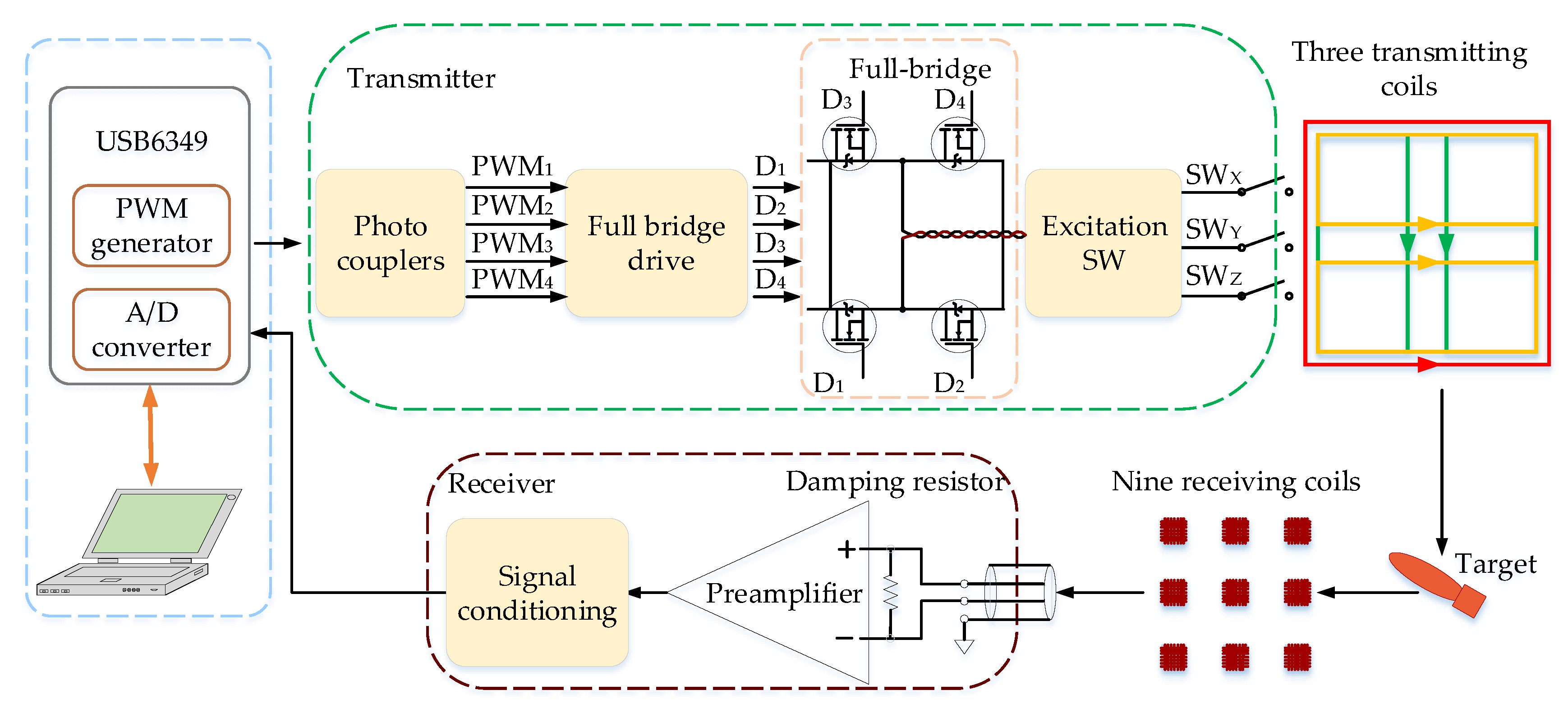

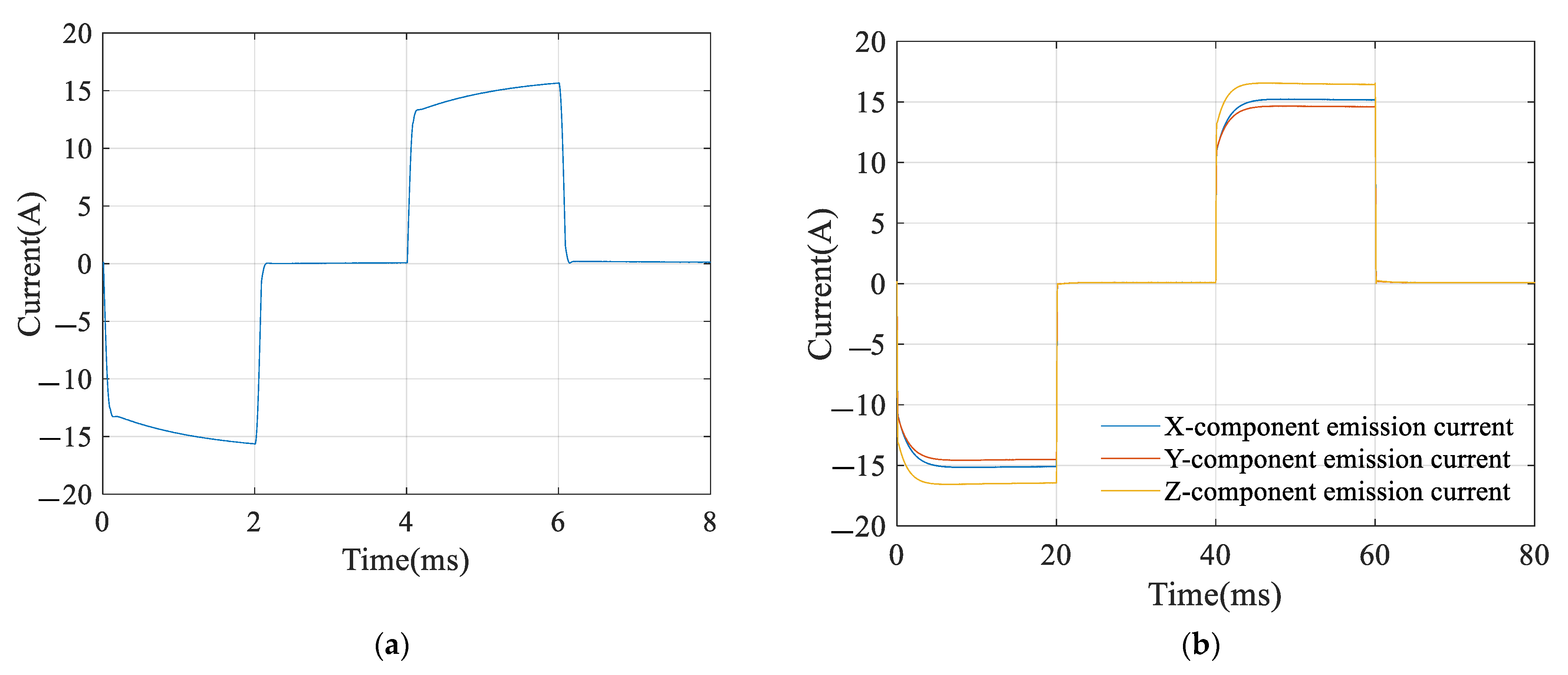
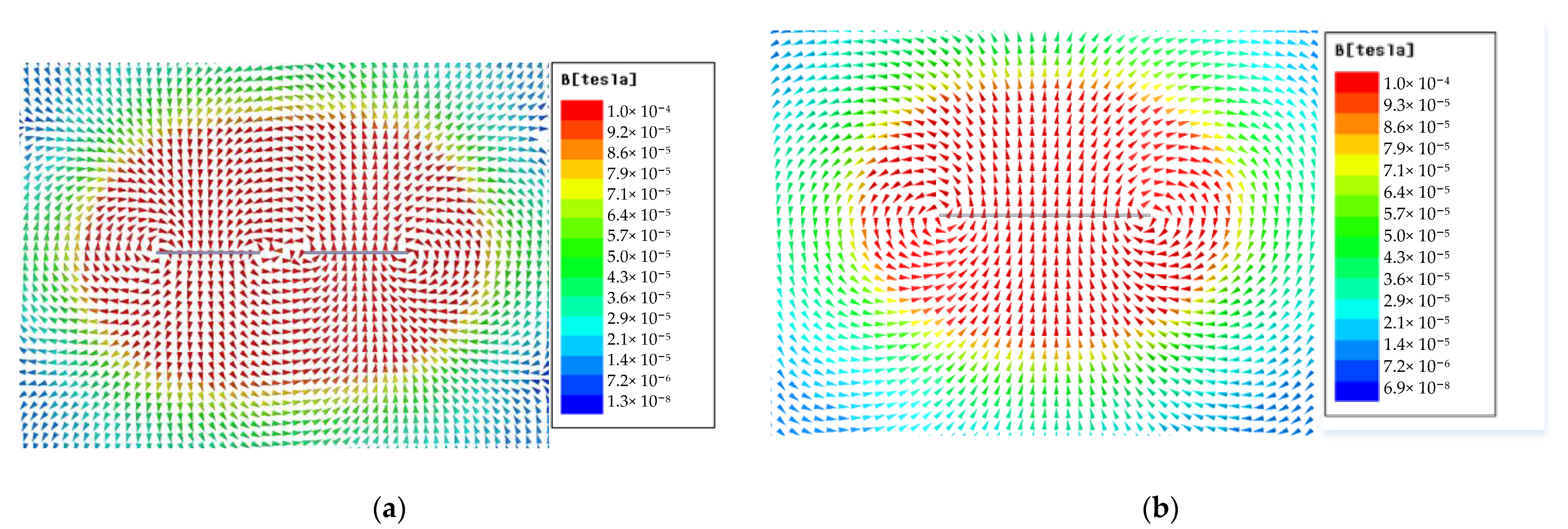
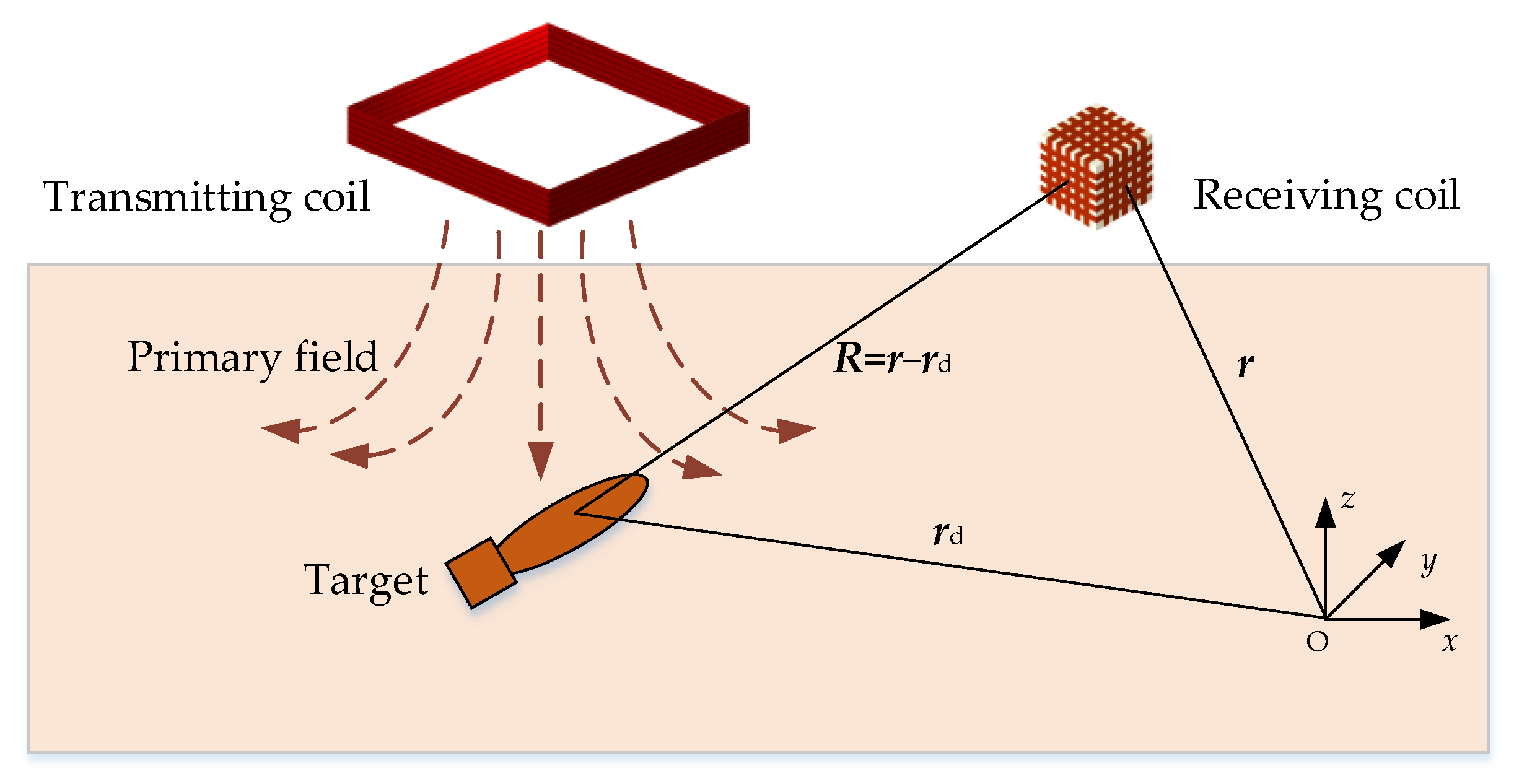


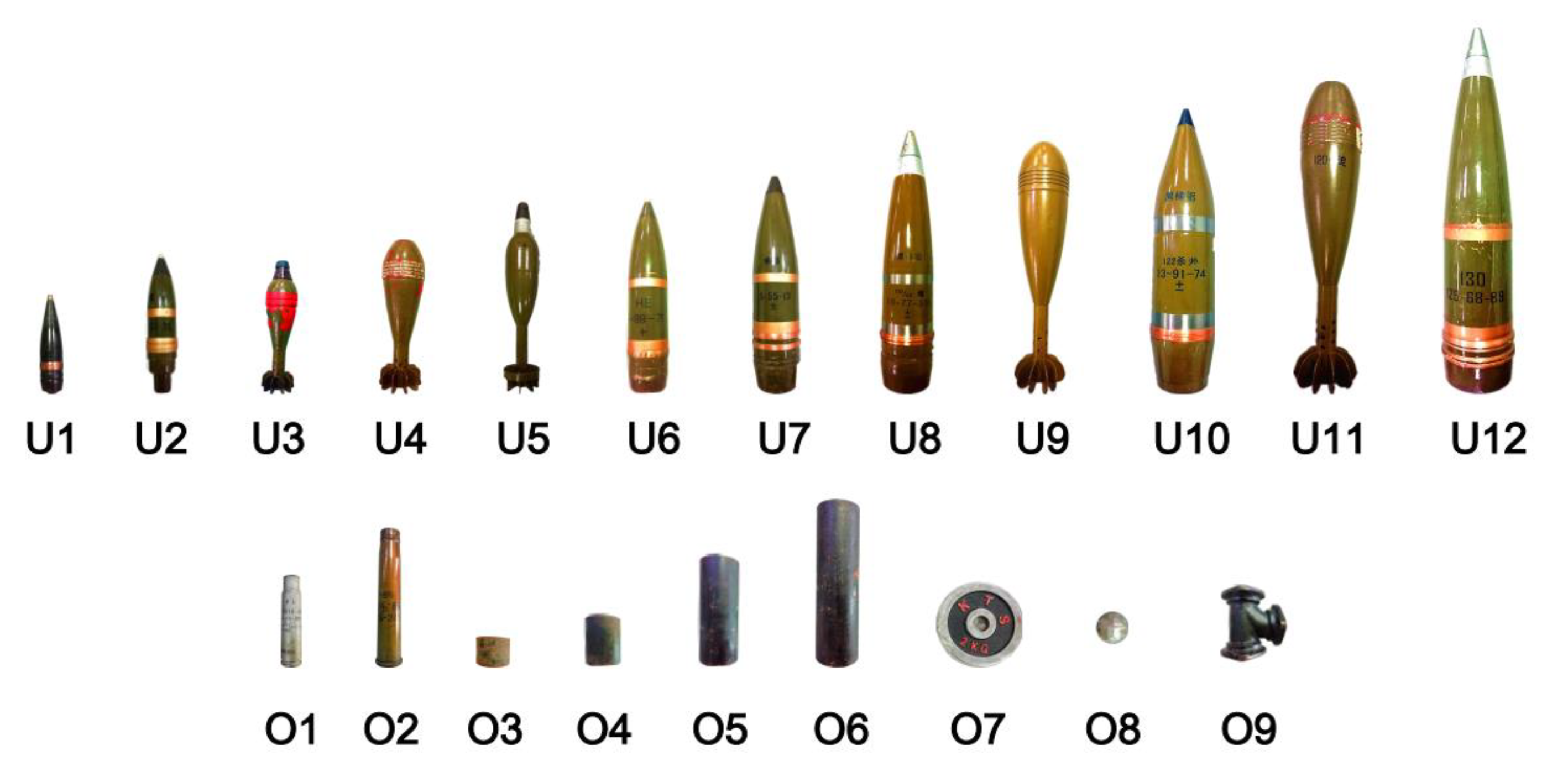
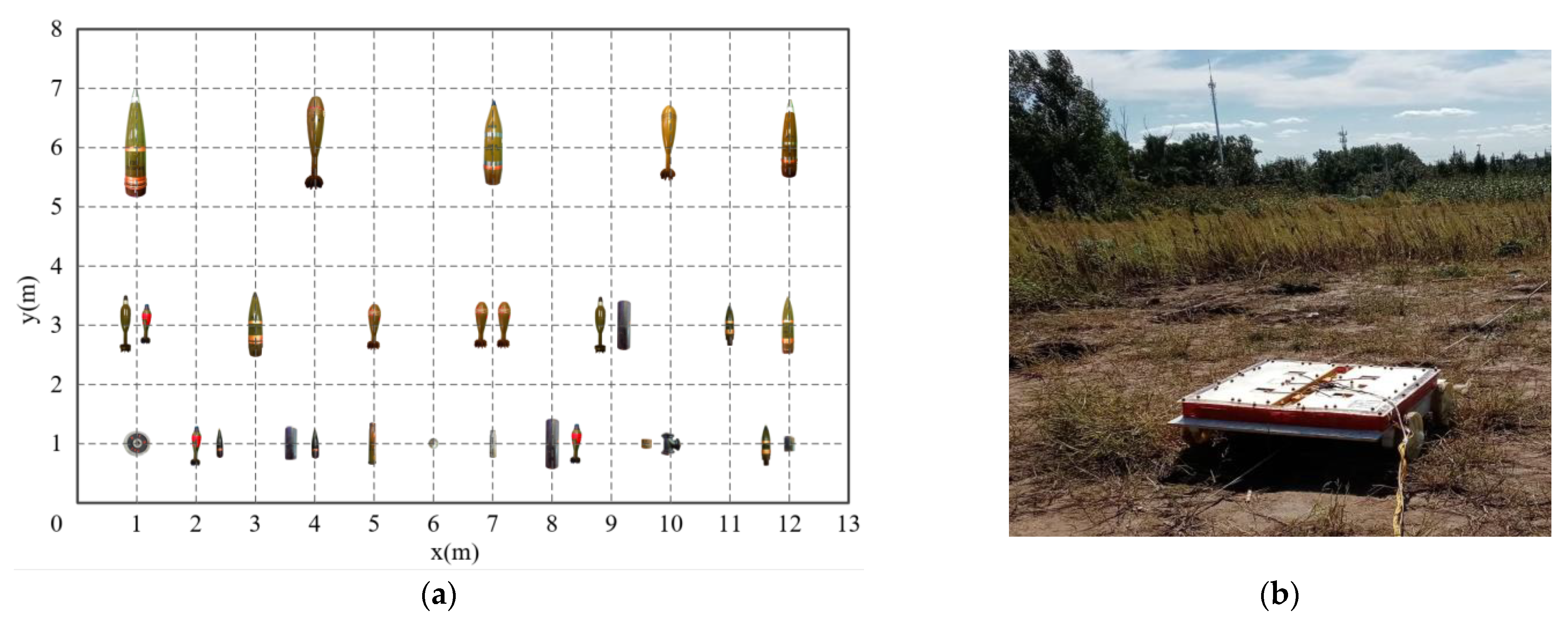
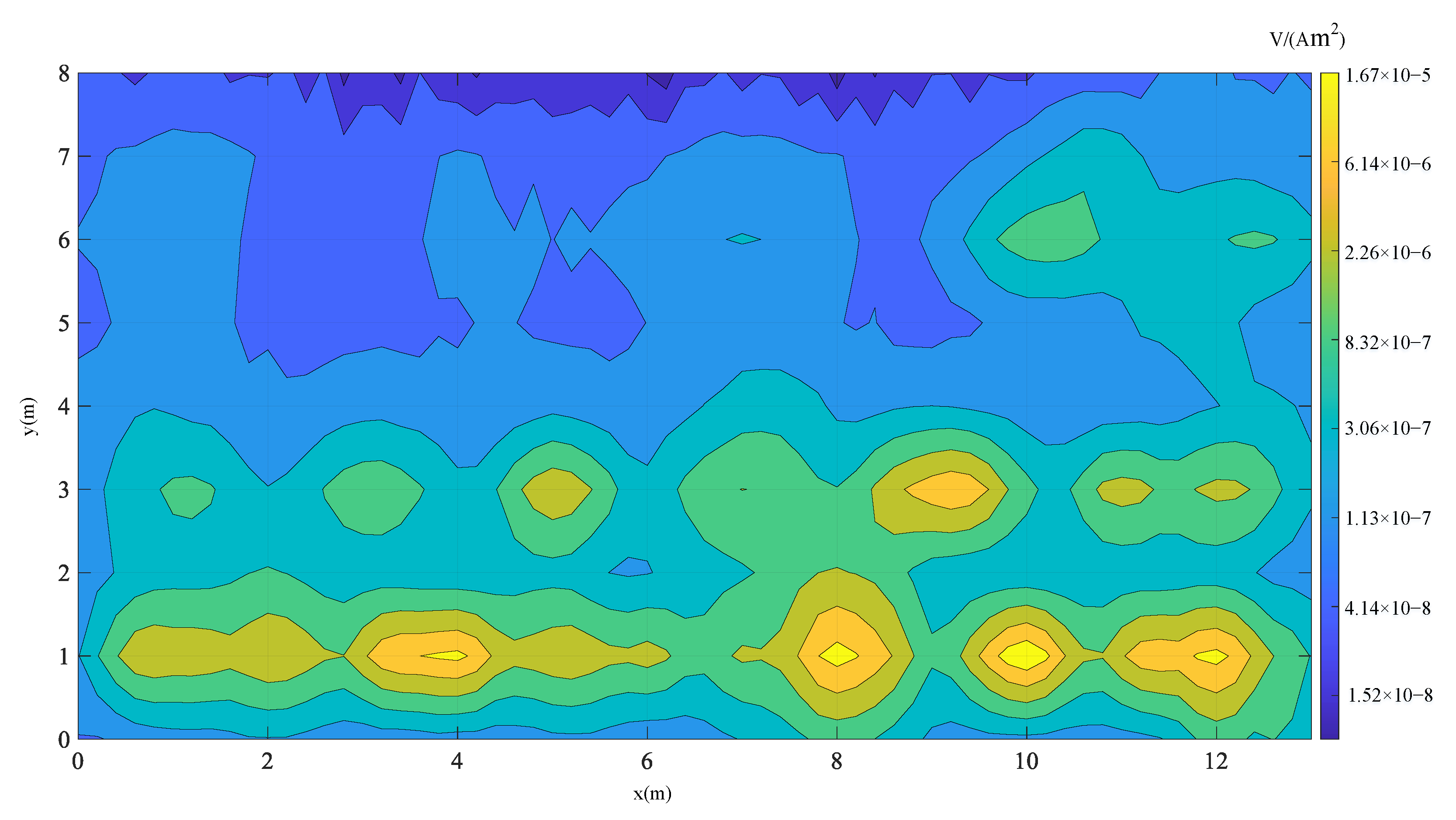
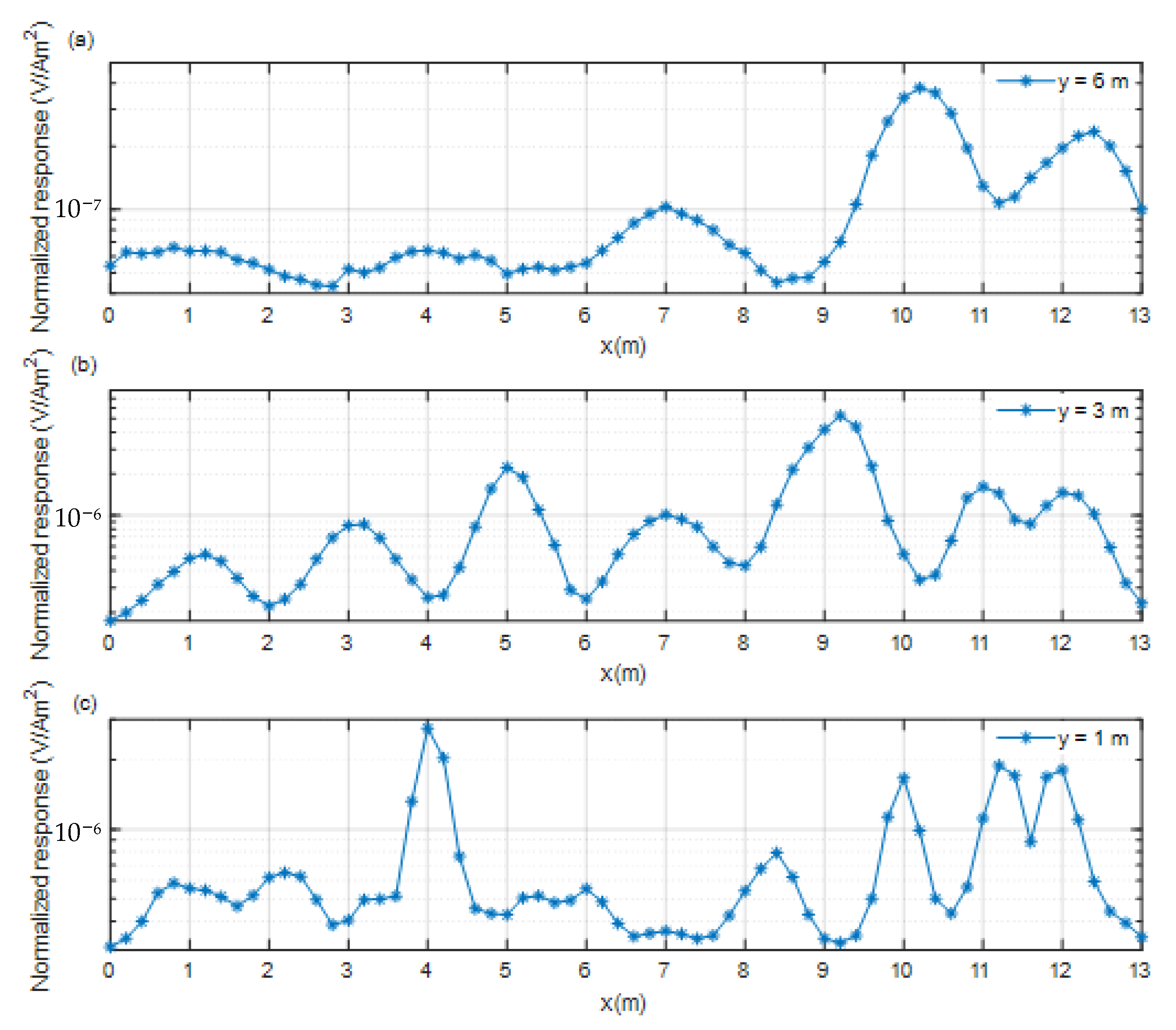
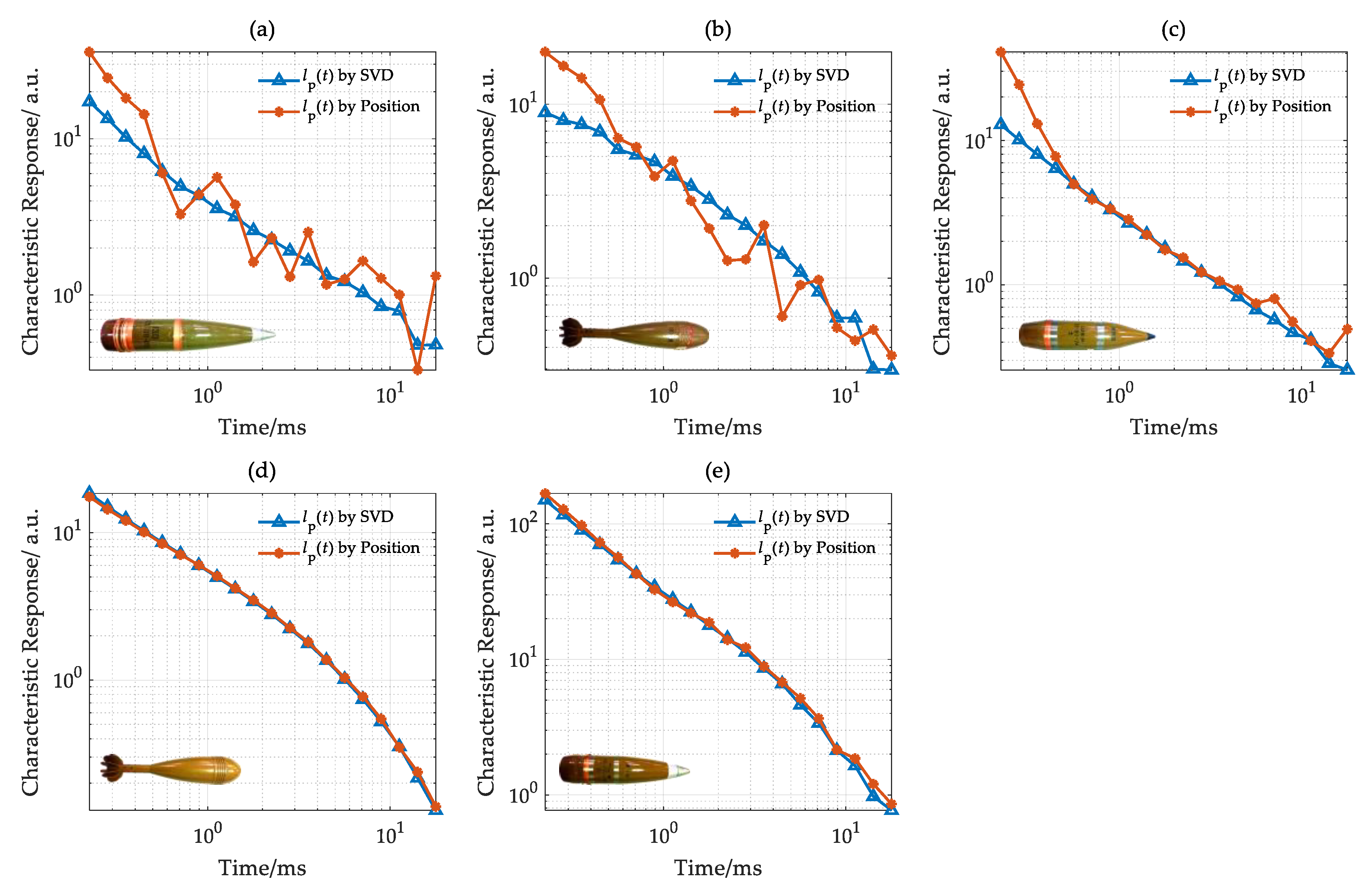
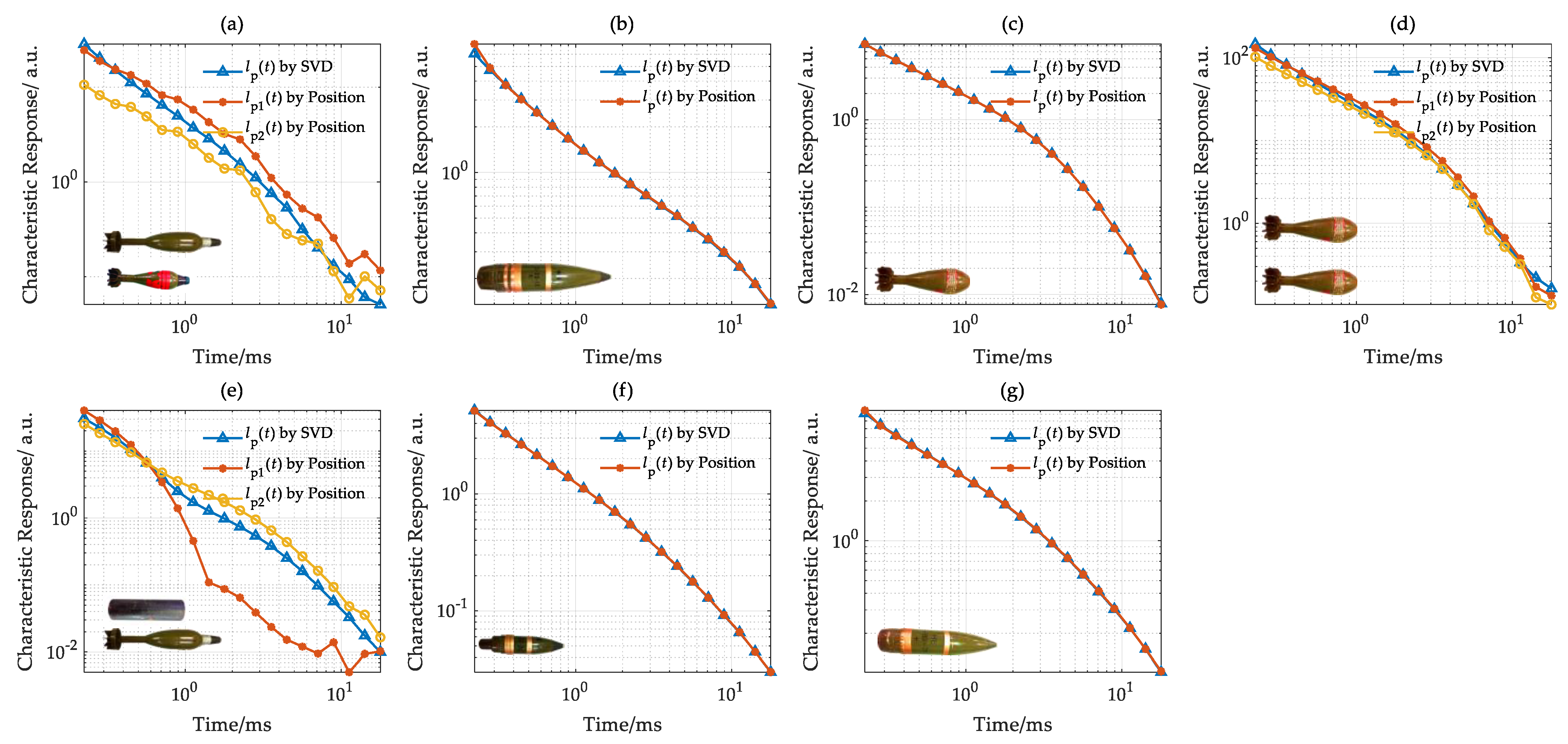
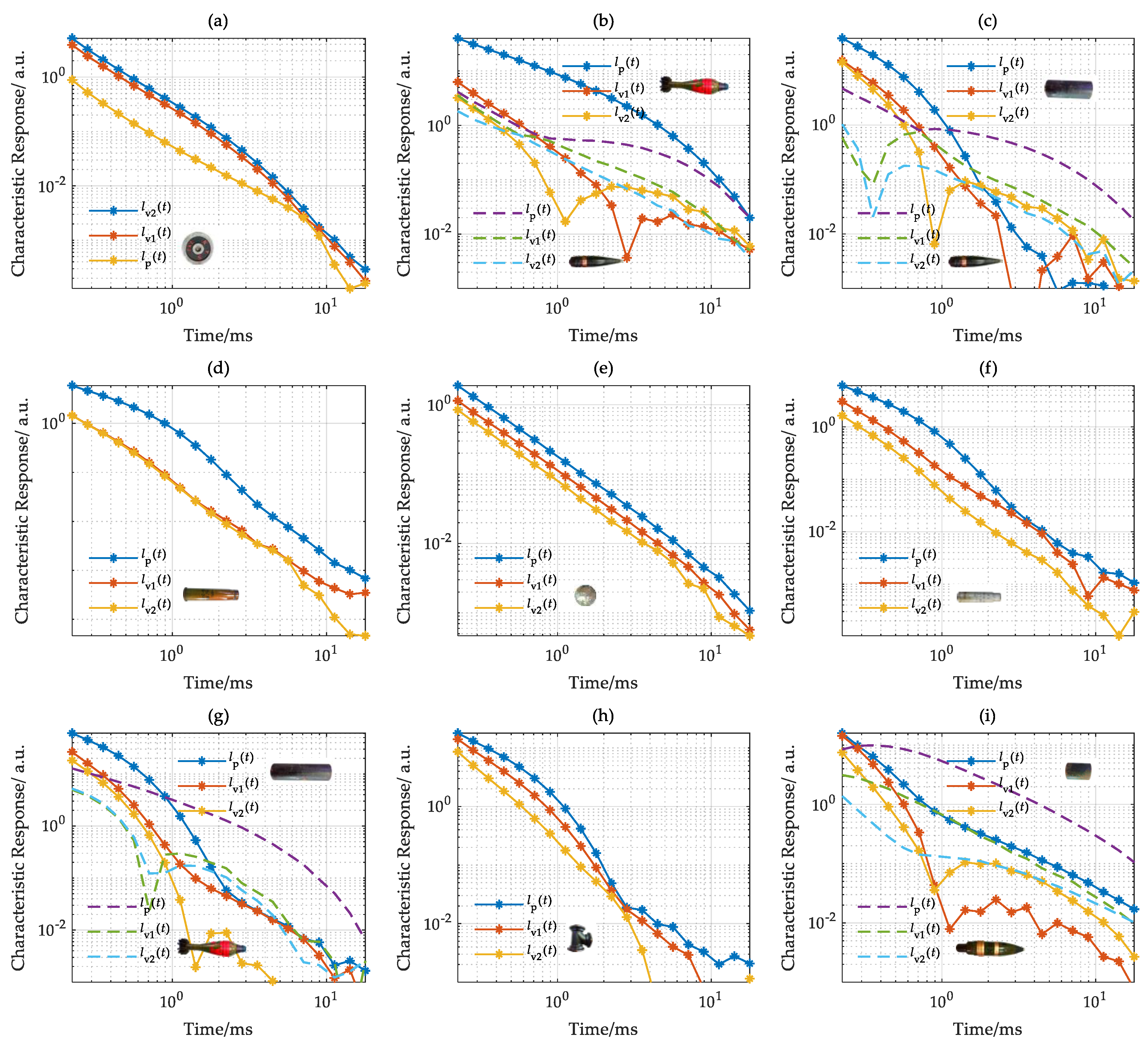
| Coil | Parameter | x | y | z |
|---|---|---|---|---|
| Transmitting coils | Length (cm) | 35 × 85 | 35 × 85 | 95 × 95 |
| Number of turns | 20 | 20 | 20 | |
| Resistance (Ω) | 0.556 | 0.564 | 0.468 | |
| Inductance (mH) | 1.312 | 1.316 | 0.958 | |
| Receiving coils | Length (cm) | 8.0 | 8.0 | 8.0 |
| Number of turns | 480 | 480 | 480 | |
| Resistance (Ω) | 108.5 | 111.3 | 114 | |
| Inductance (mH) | 18.49 | 19.12 | 19.78 | |
| Resonant frequency (kHz) | 231 | 230 | 230 |
| Name | U1 | U2 | U3 | U4 | U5 | U6 | U7 | U8 | U9 | U10 | U11 | U12 |
|---|---|---|---|---|---|---|---|---|---|---|---|---|
| Length (cm) | 18 | 26 | 24 | 27 | 34 | 35 | 39 | 51 | 46 | 55 | 58 | 65 |
| Diameter (mm) | 37 | 57 | 60 | 82 | 75 | 74 | 85 | 100 | 100 | 122 | 120 | 130 |
| Number | 2 | 2 | 3 | 3 | 2 | 1 | 1 | 1 | 1 | 1 | 1 | 1 |
| Name | O1 | O2 | O3 | O4 | O5 | O6 | O7 | O8 | O9 |
|---|---|---|---|---|---|---|---|---|---|
| Length (cm) | 16 | 25 | 5 | 10 | 20 | 30 | 2 | / | 12.5 |
| Diameter (mm) | 30 | 37 | 75 | 75 | 75 | 75 | 150 | 64 | / |
| Number | 1 | 1 | 1 | 1 | 1 | 2 | 1 | 1 | 1 |
| Name | True Position (m) | Inverted Position (m) | Error (cm) | DE Algorithm (s) | Proposed Method (s) |
|---|---|---|---|---|---|
| U12 | (0.90, 0.00, −2.09) | (0.69, −0.25, −2.22) | (−21, −25, −13) | 4.02 | 0.041 |
| U11 | (4.00, 0.00, −2.06) | (3.80, −0.24, −2.14) | (−20, −24, −8) | 4.39 | 0.041 |
| U10 | (7.03, 0.00, −1.66) | (7.10, 0.03, −1.69) | (7, 3, −3) | 4.46 | 0.040 |
| U9 | (10.09, 0.00, −1.26) | (10.20, 0.05, −1.28) | (11, 5, −2) | 3.84 | 0.040 |
| U8 | (12.05, 0.00, −1.45) | (11.99, −0.06, −1.40) | (−6, −6, 5) | 3.83 | 0.040 |
| Name | True Position (m) | Inverted Position (m) | Error (cm) | DE Algorithm (s) | Proposed Method (s) |
|---|---|---|---|---|---|
| U5 | (0.84, 0.00, −1.03) | (0.94, 0.07, −1.04) | (10, 7, −1) | 3.96 | 0.042 |
| U3 | (1.19, 0.00, −1.04) | (1.09, 0.06, −1.11) | (−10, 6, −7) | 3.93 | 0.040 |
| U7 | (3.06, 0.00, −1.02) | (3.12, 0.09, −1.07) | (6, 9, −5) | 3.94 | 0.040 |
| U4 | (5.02, 0.00, −0.85) | (5.01, −0.01, −0.91) | (−1, −1, −6) | 3.92 | 0.040 |
| U4 | (6.85, 0.00, −1.06) | (6.90, 0.06, −1.07) | (5, 6, −1) | 3.91 | 0.041 |
| U4 | (7.29, 0.00, −0.80) | (7.21, −0.14, −92) | (−8, −14, −12) | 3.84 | 0.040 |
| U5 | (8.77, 0.00, −0.86) | (8.80, 0.04, −0.88) | (3, 4, −2) | 3.87 | 0.041 |
| O6 | (9.24, 0.00, −0.72) | (9.25, 0.00, −0.73) | (1, 0, −1) | 3.87 | 0.040 |
| U2 | (11.00, 0.00, −0.82) | (10.95, 0.01, −0.86) | (−5, 1, −4) | 3.85 | 0.039 |
| U6 | (12.10, 0.00, −0.98) | (12.04, 0.07, −1.02) | (−6, 7, −4) | 3.87 | 0.040 |
| Name | True Position (m) | Inverted Position (m) | Error (cm) | DE Algorithm (s) | Proposed Method (s) |
|---|---|---|---|---|---|
| O7 | (1.00, 0.00, −0.46) | (1.02, 0.03, −0.47) | (2, 3, −1) | 3.71 | 0.038 |
| U3 | (2.00, 0.00, −0.45) | (2.00, 0.06, −0.50) | (0, 6, −5) | 3.81 | 0.040 |
| U1 | (2.40, 0.00, −0.46) | (2.30, 0.03, −0.53) | (−10, 3, −7) | 3.87 | 0.039 |
| O5 | (3.60, 0.00, −0.45) | (3.62, 0.03, −0.51) | (2, 3, −6) | 3.92 | 0.040 |
| U1 | (4.00, 0.00, −0.49) | (4.01, 0.05, −0.45) | (1, 5, 4) | 3.85 | 0.038 |
| O2 | (5.00, 0.00, −0.50) | (4.96, 0.08, −0.52) | (−4, 8, −2) | 3.76 | 0.039 |
| O8 | (6.00, 0.00, −0.47) | (6.05, 0.14, −0.49) | (5, 14, −2) | 3.88 | 0.040 |
| O1 | (6.98, 0.00, −0.46) | (7.04, 0.10, −0.52) | (6, 10, −6) | 3.87 | 0.040 |
| O6 | (8.00, 0.00, −0.46) | (8.00, 0.10, −0.41) | (0, 10, 5) | 3.83 | 0.041 |
| U3 | (8.40, 0.00, −0.47) | (8.50, 0.12, −0.48) | (10, 12, −1) | 3.81 | 0.039 |
| O3 | (9.60, 0.00, −0.46) | / | / | / | / |
| O9 | (10.00, 0.00, −0.43) | (10.04, 0.11, −0.41) | (4, 11, 2) | 3.83 | 0.038 |
| U2 | (11.60, 0.00, −0.42) | (11.61, 0.10, −0.44) | (1, 10, −2) | 3.84 | 0.039 |
| O4 | (12.00, 0.00, −0.45) | (11.91, 0.10, −0.52) | (−9, 10, −7) | 3.81 | 0.038 |
Publisher’s Note: MDPI stays neutral with regard to jurisdictional claims in published maps and institutional affiliations. |
© 2022 by the authors. Licensee MDPI, Basel, Switzerland. This article is an open access article distributed under the terms and conditions of the Creative Commons Attribution (CC BY) license (https://creativecommons.org/licenses/by/4.0/).
Share and Cite
Wang, L.; Zhang, S.; Chen, S.; Luo, C. Fast Localization and Characterization of Underground Targets with a Towed Transient Electromagnetic Array System. Sensors 2022, 22, 1648. https://doi.org/10.3390/s22041648
Wang L, Zhang S, Chen S, Luo C. Fast Localization and Characterization of Underground Targets with a Towed Transient Electromagnetic Array System. Sensors. 2022; 22(4):1648. https://doi.org/10.3390/s22041648
Chicago/Turabian StyleWang, Lijie, Shuang Zhang, Shudong Chen, and Chaopeng Luo. 2022. "Fast Localization and Characterization of Underground Targets with a Towed Transient Electromagnetic Array System" Sensors 22, no. 4: 1648. https://doi.org/10.3390/s22041648
APA StyleWang, L., Zhang, S., Chen, S., & Luo, C. (2022). Fast Localization and Characterization of Underground Targets with a Towed Transient Electromagnetic Array System. Sensors, 22(4), 1648. https://doi.org/10.3390/s22041648





